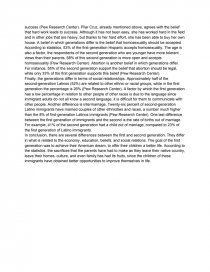Differences Between Firsts and Second Generation Immigrants
Essay by Brenda Torres • May 7, 2019 • Essay • 1,086 Words (5 Pages) • 1,380 Views
Essay Preview: Differences Between Firsts and Second Generation Immigrants
Differences Between First and Second-Generation Immigrants
In 2002, Latinos became the largest minority in the United States. There are approximately 50.5 million Hispanics representing about 16 percent of the U.S. population, according to the 2010 U.S. Census Bureau population estimate (Cardenas and Kerby). Most Latinos in the United States believe in the American dream, but for some, especially the first generation of immigrants, that is, those who were born and raised in another country and emigrated to the United States, it is very difficult to reach that dream. In contrast, for the second generation of immigrants, those who were born in the United States and who have parents who are immigrants may have better opportunities than their parents. Between these two generations are some differences related to the economy, education, beliefs and social relationships.
Between the first and the second generation of immigrants, there is a difference in terms of economic success. As an example, the first generation’s common income is $45,800 whereas the second generation's common income is $58,100 (Pew Research Center). According to Pilar Cruz, a first-generation immigrant, make less than the second generation. She says this because it is difficult to find a job that pays good, willing to hire people that don’t speak English and don’t have documents, any high school, or GED diplomas. The second difference is home ownership. For example, 13% more of the second generation’s own a home compared to the first generation (Pew Research Center). Because of the fact that the second generation has a better job and a higher income compared to their parents, they can have more possibilities to own a home. The third difference is poverty. For instance, 18% of the first generations of immigrants live in poverty, while the second generation’s 6% suffer less poverty (Pew Research Center).
First-generation immigrants differ from second-generation immigrants in terms of education. The first generation, their level of high school completion is below that of the second generation's. For example, 28% of the first generation of immigrants did not complete their high school diploma; on the other hand, only 10% of the children of the first generation did not obtain their high school diploma (Pew Research Center). Another difference is the college degree. Those who are part of the second generation the percentage of a college degree is higher compared to the first generation. According to a Pew Research Center analysis of U.S. Census Bureau data, 29% of the first generation do not have a college degree while 7% more of those who have parents of the first generation obtained a college degree (Pew Research Center). Pilar Cruz obtained her high school diploma but could not continue with her studies. She said the reason behind this was that when she came to the United States, she was alone, and because of this she had to provide food and shelter for herself with the help of no one. As a result, she had no other choice but to work, and give up her educational dream. In terms of language, 90% of second-generation Latinos speak English, a big difference compared to the first generation of immigrants who only 48% speak English (Pew Research Center). Language proficiency greatly increases in the second generation.
In addition to the differences between the first generation and those who have immigrant parents related to economics and education, there are also differences in their beliefs. One of the beliefs is hard work results in success. The first generation of Latinos is optimistic about the belief of having success working hard. For example, 78% say that most people can achieve success through their work; likewise, the second generation agrees that hard work leads to success (Pew Research Center). Pilar Cruz, already mentioned above, agrees with the belief that hard work leads to success. Although it has not been easy, she has worked hard in the field and in other jobs that are heavy, but thanks to her hard effort, she has been able to buy her own house. A belief in which generations differ is the belief that homosexuality should be accepted. According to statistics, 53% of the first-generation Hispanic accepts homosexuality. The age is also a factor, the respondents of the second generation who are younger have more
...
...


